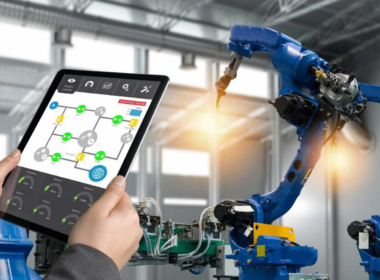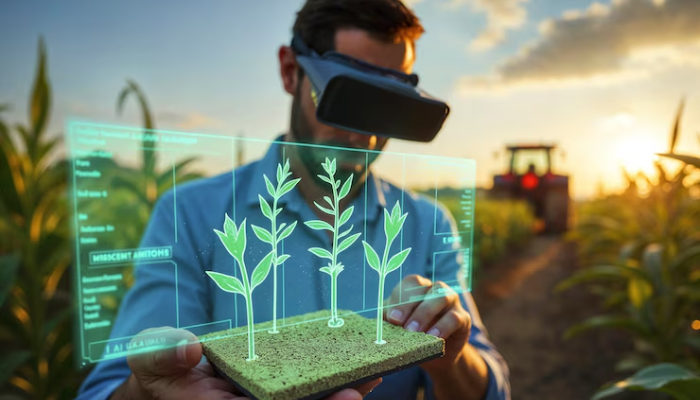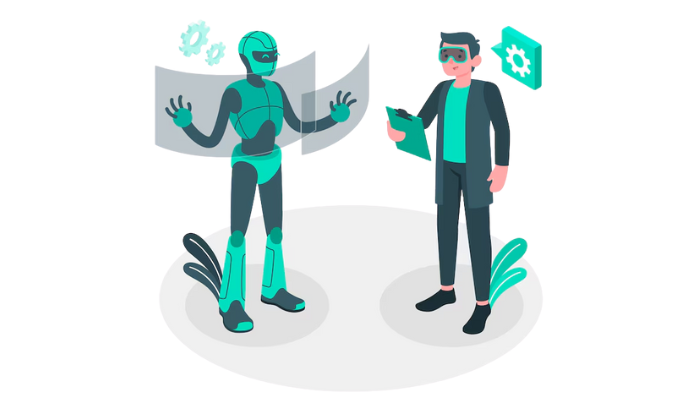Agriculture is at a turning point. Traditional methods are struggling to keep up with rising food demand, climate uncertainty, labor shortages, and the need to use resources more efficiently. To stay competitive and sustainable, farms are adopting advanced technologies. Artificial intelligence is leading that shift.
How will AI affect the agriculture industry? It’s helping you make decisions faster, respond to challenges earlier, and grow more with fewer resources. For instance, AI-enabled systems have helped smallholder farmers in India increase their income stability by up to 10% through better crop timing and disease alerts.
In the sections that follow, you will learn how AI is improving core farming operations, which tools are delivering the most value, and what steps you can take to begin applying AI on your farm or agri-business.
Why AI in Agriculture Now?
Adopting AI in agriculture is no longer optional. It is becoming essential for addressing the increasing complexity of farming. From climate unpredictability to rising operational costs, AI offers the clarity and control needed to navigate these challenges with confidence.
- Climate Instability Requires Smarter Planning
Unpredictable weather conditions are making traditional farming calendars unreliable. Longer droughts, shorter growing seasons, and erratic rainfall patterns are disrupting yields across regions. AI helps you adjust with precision. Forecasting models use weather data, satellite imagery, and historical trends to support timely planting, irrigation, and harvesting decisions.
- Labor Shortages and Higher Input Costs Call for Automation
With labor availability declining and input costs rising, farms need more efficient ways to manage field operations. AI-powered software systems help by analyzing real-time data such as crop stage, soil conditions, and weather patterns to generate optimized task schedules and input plans.
These systems recommend when to irrigate, apply nutrients, or deploy labor based on current field conditions. This reduces manual guesswork, minimizes waste, and helps maintain productivity even with limited resources.
- Technology Costs Are Dropping
Adopting AI no longer requires major capital investment or complex infrastructure. With the increasing availability of cloud-based machine learning platforms, mobile-ready dashboards, and scalable APIs, farms of all sizes can now implement intelligent decision systems without replacing their existing tech stack.
- Data-Driven Farming Is Becoming Standard
More agricultural decisions are now based on real-time data rather than estimates or intuition. With AI, you can analyze crop health, soil nutrients, moisture levels, and market conditions in one integrated system. This shift to data-backed decisions supports more precise input use, reduces waste, and improves overall sustainability.
Now that we’ve seen why AI is gaining ground, let’s look at the specific challenges it’s helping to solve on farms of all sizes.
Challenges Farmers Face Today
Even with better tools, farming remains unpredictable. AI adoption is growing because it offers clear solutions to some of the most persistent operational problems.
- Inefficient Input Use
Applying too much or too little fertilizer or water affects yield, costs, and soil health. Without precise data, it’s difficult to make informed decisions. AI tools analyze moisture, temperature, and nutrient data to guide targeted input application. This helps improve plant health while minimizing waste and runoff.
- Crop Disease and Pest Outbreaks
Pests and diseases continue to cause major crop losses worldwide. Manual scouting is time-consuming and often reactive. AI-enabled image recognition and monitoring systems can detect early signs of stress or infection, helping you take action before damage spreads. These systems improve response times and reduce reliance on broad-spectrum chemical treatments.
- Market Volatility and Income Risk
Price swings and uncertain demand make it hard to plan harvests and predict income. AI tools that track market trends, supply chain data, and commodity pricing can help you decide when to harvest, store, or sell. This kind of visibility leads to better financial planning and less exposure to sudden shocks.
- Complex Regulations and Compliance
Environmental standards are tightening. Whether it’s limits on pesticide usage, carbon emissions, or water consumption, compliance requires accurate tracking and documentation. AI platforms automate data collection and reporting, making it easier to meet requirements without adding administrative burden.
AI is not replacing the farmer. It is making your role more informed, more strategic, and more sustainable. It allows you to work smarter with every season. With these challenges in mind, let’s explore how AI is being applied across specific farm operations.
Key Areas Where AI Is Changing Farming Operations
AI is not limited to one part of the farm. It is changing how you grow, plan, harvest, and sell. By connecting real-time data with automated decisions, AI improves visibility and control across your operations.
Below are five high-impact areas where AI is already delivering measurable value.
1. Precision Farming and Crop Monitoring
AI software gives you a zone-level view of crop health that manual scouting often misses. Computer vision models analyze field images captured through mobile apps or sensor-based platforms to detect early signs of disease, pest stress, or nutrient deficiency. These insights are delivered as timely alerts, helping you take action before yield loss occurs.
For example, AI tools can identify chlorosis or patchy growth patterns in specific sections of a field, allowing for targeted treatment instead of applying inputs across the entire area. This improves input efficiency and supports soil health over time.
2. Predictive Analytics for Crop Planning
AI gives you the ability to look forward with more certainty. Predictive analytics tools combine historical weather patterns, soil data, and current sensor inputs to forecast optimal planting and harvesting windows. These tools also estimate expected yields and flag possible risks.
IBM’s Watson Decision Platform for Agriculture offers integrated forecasting tools that help farming businesses adjust plans in real time. With this level of insight, you can reduce guesswork, avoid overplanting, and align harvest schedules with market conditions.
This strategic planning leads to fewer surprises and more consistent revenue.
3. Smart Irrigation and Water Management
Water availability is becoming a limiting factor in many regions. AI systems help you manage irrigation with precision. By combining weather forecasts, soil moisture readings, and crop data, these systems calculate the exact amount of water each zone needs.
Platforms like CropX and Arable use AI to deliver these insights through user-friendly dashboards, helping farms reduce water waste and improve plant health.
Smart irrigation lowers utility bills and supports compliance with water use regulations. It also builds long-term resilience against drought and water shortages.
4. Supply Chain Optimization and Market Forecasting
Getting your crops to market efficiently is just as important as growing them. AI helps you forecast demand, set pricing strategies, and manage logistics. By analyzing market trends, inventory data, and regional supply fluctuations, AI systems help you plan more accurate harvest volumes and avoid spoilage.
For example, platforms like Agribuddy, Fasal, and AgroStar use AI to connect farmers with buyers, track delivery logistics, and provide crop-specific pricing recommendations.
These tools reduce post-harvest losses, shorten supply chains, and improve cash flow by aligning production with actual market needs. From field to market, these capabilities are reshaping the way farms operate. But how do these changes translate into real outcomes?
Real-World Impact: What Results Are Farmers Seeing?
Farmers adopting AI are seeing results that go beyond experimentation. From higher yields to smarter supply chains, AI is delivering meaningful, measurable outcomes across diverse agricultural settings.
Performance Gains Across the Field
- In California, AI-assisted vineyards improved grape yields by 25 percent and reduced water consumption by 20 percent by optimizing irrigation schedules
- In Kenya, smallholder coffee farmers using AI crop advisory tools increased productivity from 2.3 to 7.3 tonnes per hectare while reducing fertilizer use
- In Brazil, adoption of AI and precision agriculture is growing rapidly, with the market expected to expand at a compound annual growth rate of over 19 percent through 2033
These gains are not isolated. They reflect a broader trend of AI becoming a practical tool for decision-making and risk reduction.
Global Adoption Trends
- United States: Commercial farms are integrating AI into machinery and logistics to overcome labor shortages and improve compliance tracking
- India: AI tools for weather forecasting and disease prediction are helping small and mid-sized farms adapt to climate risks and increase income stability
- Brazil: Supported by public-private partnerships, the country is scaling AI adoption through smart irrigation systems and market intelligence tools
Codewave’s Role in Agri-Tech
Codewave works with agricultural enterprises to build AI-powered systems that improve crop health, yield predictability, and overall farm efficiency. Our solutions include crop growth monitoring, farm automation, and livestock management software that are developed through a consultative approach that aligns with your goals.
From early disease detection to remote machinery monitoring, our work helps you digitize operations and respond quickly to demand shifts across the supply chain.
You can explore how Codewave is enabling smart precision farming, farm automation, and AI-powered analytics here. With outcomes like these, AI tools are gaining traction across farms of all sizes. But which platforms are making the biggest difference today?
AI Tools Empowering Modern Farmers
AI in agriculture is not just about analytics or automation. It’s about giving farmers practical tools they can use on the ground to monitor, diagnose, and act quickly. The tools listed below are already helping farms become more efficient, more precise, and more resilient.
| Tool / Platform | Use Case | Benefits |
| Taranis | Remote crop scouting | Uses high-resolution aerial imagery analyzed by AI to detect weeds, pests, and nutrient issues early. Helps reduce crop loss and improve health. |
| Plantix (by PEAT) | Plant disease diagnosis | Mobile app that uses AI to identify diseases through photos and provides real-time treatment suggestions. Connects farmers with local resources. |
| FarmWise | AI-driven weeding robots | Autonomous machines identify and remove weeds with precision, reducing herbicide usage and saving labor costs. |
Instead of replacing human expertise, AI is supporting it while handling data-heavy tasks so you can focus on strategy, timing, and outcomes.
Will AI Replace Farmers? A Collaborative Future
AI is advancing rapidly, but it is not eliminating farmers. It is changing what your day looks like, what skills your team needs, and how decisions are made.
In practice, this shift means that you are no longer only working with seeds, soil, and schedules. You are working with dashboards, drone footage, crop simulation models, and yield forecasts. Many farms are now hiring or upskilling for roles that barely existed a few years ago.
Here’s how responsibilities are evolving on AI-enabled farms:
- Agronomist-analysts are combining crop science with predictive modeling. These professionals analyze satellite imagery, weather forecasts, and plant health data to refine fertilizer schedules or detect early disease stress in specific zones of a field.
- Drone operators are now essential on farms using aerial scouting. They collect multispectral images that AI systems process to detect issues invisible to the eye, such as chlorophyll deficiencies or uneven germination.
- Soil and telemetry specialists manage IoT sensor networks that report real-time data on pH levels, moisture content, and compaction. This role ensures data quality and translates insights into field-level recommendations.
Even smaller farms are adapting. A vegetable grower managing 20 acres may now use an app to receive irrigation suggestions based on AI analysis of local weather, evapotranspiration rates, and soil saturation. A rice farmer in India might use an AI chatbot to identify a pest and get recommended treatments within minutes, in their local language.
You are still making the final call. But AI is reducing the time between problem and solution, and helping you avoid costly errors by surfacing risks earlier. It allows you to farm proactively, not reactively.
Risks, Ethics, and Limitations of AI in Agriculture
While AI brings clear advantages to farming operations, it also introduces risks that must be managed carefully. Understanding these limitations helps you make more responsible and effective decisions when adopting new technologies.
- Data Privacy and Model Bias
AI tools depend on large volumes of data collected from sensors, drones, and connected devices. This raises questions around data ownership and privacy. When third-party platforms store and analyze your field data, you may lose control over how that data is used or monetized. It is important to choose vendors with transparent data policies and user control options.
Another challenge is bias in the AI models themselves. If the training data is drawn from a specific geography or crop system, the recommendations may not apply well to your farm. This can lead to inaccurate suggestions or missed issues. Make sure any system you use can be calibrated to local conditions and reviewed by agricultural experts.
- Access Gaps Between Large and Small Farms
Many AI tools require an initial investment in devices, connectivity, and technical support. Large farms can typically absorb these costs and scale quickly. Small and mid-sized farms may not have the same financial or digital readiness.
This creates an adoption gap, where benefits are concentrated among larger operations. If left unaddressed, it could widen disparities in productivity and income. Affordable, offline-first, or shared-service AI solutions are essential to make adoption more inclusive.
- Environmental Oversights and Overdependence
Most AI models are designed to optimize inputs and efficiency. However, they may not fully account for soil health, biodiversity, or long-term ecological balance. For example, an AI recommendation might focus on maximizing yield with higher input use, without considering sustainability trade-offs.
There is also the risk of overdependence on automated systems. If operators rely completely on technology without staying close to field conditions, small issues can go unnoticed until they become larger problems. AI should support your judgment, not replace it.
Maintaining a strong connection to the land, backed by intelligent tools, leads to better outcomes than relying entirely on software.
Getting Started with AI in Agriculture
If you’re exploring AI for your farm or agribusiness, the best place to begin is with a focused, low-risk plan. AI implementation does not require overhauling everything at once. It starts with identifying clear problems, selecting the right tools, and building a foundation that can scale over time.
Steps for Agribusinesses and Farmers
Here’s how you can take the first steps toward applying AI in a way that delivers practical, measurable value.
1. Identify Specific Operational Pain Points
Look at where inefficiencies consistently occur. This could be late pest detection, inconsistent irrigation, unpredictable harvest timing, or input overuse. Choose one or two areas where small improvements could deliver visible returns.
2. Start with Sensor and Analytics-Based Solutions
Instead of jumping straight into full automation, begin with systems that collect and visualize data such as soil sensors, weather monitoring, or drone-based imaging. This helps you understand your fields better and prepares your team for data-driven decisions.
3. Partner with a Tech Provider to Run a Pilot
A well-defined pilot can help validate AI’s value in your context. Focus on a specific field or operation for a single season. Use this time to evaluate accuracy, ease of use, and business impact.
4. Train Staff and Align Daily Workflows
Even the best AI tools need people to use them effectively. Invest in basic training for your team to read dashboards, interpret alerts, and act on AI-generated insights. Integrate the technology into existing processes gradually to reduce friction.
Codewave’s Approach to Agri-AI
At Codewave, we work with agricultural enterprises to build AI strategies that match real-world conditions and long-term goals. Our approach starts with understanding your operational context: crop type, farm size, climate zone, and resource constraints.
We help clients run agile pilots that combine sensor data, edge computing, and AI models hosted on secure cloud platforms. These systems are built for interoperability, allowing integration with drones, irrigation controllers, and mobile apps used in the field.
In past engagements, our solutions have helped clients improve early disease detection accuracy and optimize irrigation timing. These changes reduced manual checks and improved yield consistency across growing cycles. Explore our portfolio to see what we’ve delivered across industry.
Conclusion: Cultivating the Future with AI
Agriculture is entering a phase where decisions are no longer driven by intuition alone. Data is becoming a strategic asset, and AI is the tool that helps you act on it with speed and accuracy. From optimizing input use to improving harvest quality and timing, AI is helping farms operate more precisely and profitably.
At Codewave, we make this transition practical. Our goal is not just to deploy AI, but to make it work for your specific environment. Whether you’re managing 50 acres or overseeing a nationwide agribusiness, we help you bring intelligence to your field operations, supply chains, and digital tools.
How We Support Agri-AI Transformation
We partner with you end to end, from identifying the right problems to building scalable AI solutions that fit your farm’s reality.
1. Defining Your Use Case Clearly
We start by identifying areas of highest impact. This could be early disease detection, optimizing irrigation cycles, or improving crop traceability. We work with your team to define clear objectives and expected outcomes.
2. Building AI-Driven Prototypes Using Your Data
We use field data, weather inputs, and crop history to develop models that solve real problems. These AI models are tested and refined using actual farm conditions to ensure they deliver meaningful results.
3. Integrating Seamlessly with Existing Systems
Our solutions are designed to work with your existing tools, that is whether you are using drone imaging, soil sensors, or mobile field apps. We ensure interoperability so you do not need to replace your entire tech stack to benefit from AI.
4. Rolling Out in Agile, Measurable Phases
We implement it in small, iterative cycles. This allows for faster feedback, smoother adoption, and minimal disruption to your operations. It also gives you early wins that can scale over time.
5. Training and Enablement for Your Team
We provide the support your team needs to understand and use the new system effectively. From field managers to agronomists, everyone gets the training to interpret insights and take timely action.
Whether your goal is to improve yield predictability, reduce water use, automate reporting, or better manage soil health, we help you do it with the right mix of AI, cloud, and connected systems.
Ready to explore AI-powered farming? Let’s talk about what is possible for your operation.
Codewave is a UX first design thinking & digital transformation services company, designing & engineering innovative mobile apps, cloud, & edge solutions.







